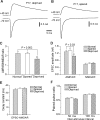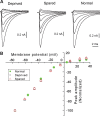A critical window for experience-dependent plasticity at whisker sensory relay synapse in the thalamus
- PMID: 19074025
- PMCID: PMC6671758
- DOI: 10.1523/JNEUROSCI.4785-08.2008
A critical window for experience-dependent plasticity at whisker sensory relay synapse in the thalamus
Abstract
This study investigated the role of sensory experience in the refinement of whisker sensory relay synapses in the ventral posterior medial nucleus (VPm) of the murine thalamus. Sensory deprivation was done by whisker plucking, and synaptic connectivity was determined by whole-cell patch-clamp recording in acute slices. Sensory deprivation started at P12-P13, but not at P16, disrupted the elimination of VPm relay synapses. The majority of deprived neurons received multiple relay inputs, whereas the majority of nondeprived neurons received a single relay input. Sensory deprivation started a few days earlier at P10, however, had no effect on synapse elimination. The disruption of synapse elimination was associated with a delay in synapse maturation. The AMPA/NMDA ratio of EPSC was significantly smaller in deprived neurons. On the other hand, deprivation had no effect on the peak amplitude or decay time constant of the NMDA component, or the I-V relationship of the AMPA component, nor does it affect the paired-pulse ratio of EPSCs. The reduction in the AMPA/NMDA ratio was already evident within 24 h of whisker plucking, and the effect is associated with a reduction in the amplitude of quantal AMPA events. Thus, P12-P13 is a critical period for experience-dependent refinement at the whisker sensory relay synapse in the VPm.
Figures






References
-
- Allen CB, Celikel T, Feldman DE. Long-term depression induced by sensory deprivation during cortical map plasticity in vivo. Nat Neurosci. 2003;6:291–299. - PubMed
-
- Belford GR, Killackey HP. The development of vibrissae representation in subcortical trigeminal centers of the neonatal rat. J Comp Neurol. 1979;188:63–74. - PubMed
MeSH terms
Substances
LinkOut - more resources
Full Text Sources
